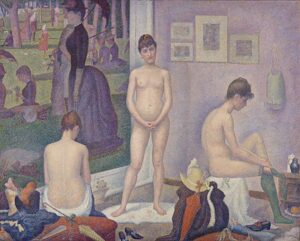George Seurat (1859-1891)
The intellect is well-suited to functioning in P-A if directed by our intuition. The creation of beauty, however, is a function of present moment intuitive inspiration. To analyze the process of painting, for example, and reduce it to scientific facts and theories about the chemical and optical aspects of color would not create a basis from which to create beautiful paintings.
This is, however, exactly what George Seurat attempted to do. “The main foundations of his pictorial conception were the chemical and physical findings of color studies and color theories, which he sought to transpose to the field of painting without any regard for the fact that these were very different media indeed. Seurat’s painterly ideal was to break down the color plane and lines into dots of contrasting colors or complementary colors in close juxtaposition. Nothing is left to chance, to the spontaneous artistic idea, to experimentation or imperfection.”[i]
If we look at Seurat’s paintings such as Model, Front View, Bathers at Asnières, and the famous Sunday Afternoon on the Island of La Grande Jatte, we see stiff, cardboard-like figures devoid of the energy and excitement of life. He believed that his Impressionist friends had reached a creative dead-end and that he could give new life and a new direction to painting.
The truth eluded Seurat as he turned in a direction that would soon run its course. “The atmosphere and appeal that gives the Impressionist paintings their charm are incalculable, for they have their roots in creativity itself, and Seurat has failed to take into account the profound significance of this.”[ii] Seurat never learned that one enters the heart and not the head (intellect) in search of beauty.
PAINTING – Intellectual Pointillism (Divisionism)
[i] Walther, Ingo F. [ed.]. Masterpieces of Western Art. Hong Kong: Taschen. 1996, page 506.
[ii] Ibid.
____________________________________________________________
Pointillism Table of Contents
___________________________________________________________
Find a much more in-depth discussion in books by Roy Charles Henry.



